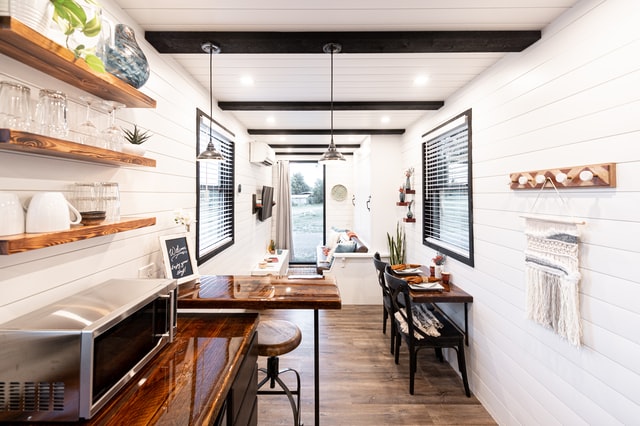House flipping can be an exciting and lucrative way to invest in real estate, but it’s not without its risks. Whether you’re a seasoned investor or a first-time house flipper, it’s important to have a solid understanding of the process and the market before you get started. In this ultimate beginner’s guide to house flipping, we’ll cover everything you need to know to successfully flip a house, from researching the market to closing the sale. So, whether you’re looking to make a quick profit or build a successful real estate business, read on for expert tips and advice on how to flip houses like a pro.
What is house flipping?
House flipping is the process of purchasing a property with the intent of renovating it and then reselling it for a profit. The goal of house flipping is to increase the value of the property through renovations and improvements and then sell it quickly at a higher price than what was paid for it.
People get into house flipping for a variety of reasons. For some, it’s a way to make a quick profit by buying a property at a low price, renovating it, and then selling it for a higher price than their initial investment. Others see house-flipping as a way to build long-term wealth by acquiring properties, improving them, and then holding onto them for rental income or reselling them for a profit in the future. Some people also enjoy the creative process of renovating and improving properties and find house flipping to be a satisfying and fulfilling hobby or career.
House flipping differs from buying real estate as a long-term investment in several key ways.
First, house flipping involves a higher level of risk than buying real estate for long-term investment purposes. Flippers are typically looking to buy a property at a low price, make updates and repairs quickly, and then sell it for a profit within a relatively short timeframe. This means that flippers are more susceptible to fluctuations in the housing market and changes in interest rates.
House flipping also requires a greater amount of active involvement and management than buying real estate as a long-term investment. Flippers need to be knowledgeable about the renovation process, have access to financing, and have the ability to oversee contractors and manage the project timeline.
And finally, the goals of house flipping and long-term real estate investment are often different. House flippers mostly want to make some money quickly, while long-term investors are more concerned with generating steady rental income and building long-term wealth through appreciation.
How to get into house flipping
Getting into house flipping can be an exciting and potentially lucrative venture, but it’s important to approach it with a clear plan and a solid understanding of the process to make sure it’s a wise investment. Here are some steps to consider when getting into house flipping:
- Start by researching the local real estate market. Look for areas where property values are rising and demand is high. Consider factors such as location, school district, and access to amenities.
- Securing the funding for your house flipping venture may involve applying for a mortgage or a line of credit. Be sure to shop around for the best rates and terms.
- Look for a suitable property to flip. Look for properties that are in need of renovations or that have the potential for value-added improvements. Work with a real estate agent who specializes in investment properties to help you find potential flips.
- Assess the potential profit margins. Calculate the costs of renovations and improvements, along with the estimated sale price of the property after it’s been flipped. Be sure to factor in any holding costs such as property taxes, insurance, and utilities.
- Create a budget and timeline for the renovations. Work with a contractor to create a plan for the renovations and improvements needed to increase the property value. Be sure to set a realistic timeline for the project and plan a budget for unexpected expenses.
- Oversee the renovation process. Keep a close eye on the progress of the renovations and work with the contractor to ensure that the project stays on track and within budget.
- Sell the property. Once the renovations are complete, list the property for sale and work with a real estate agent to market it effectively. Be prepared to negotiate offers and close the sale quickly.
It’s important to remember that house flipping involves a certain level of risk, and success is never guaranteed. It’s also important to have a solid understanding of the local real estate market, and to work with experienced professionals throughout the process. With careful planning and a solid strategy, however, house flipping can be a rewarding and potentially lucrative venture.
Raising capital to flip houses
There are several ways to raise capital to start house flipping. Here are some options:
- One of the easiest ways to raise capital for house flipping is through personal savings. This requires discipline and saving up over time to build up a significant amount of capital.
- If you’re considering house flipping as an investment strategy, obtaining a loan for investment property can be a viable option to raise capital. These loans are specifically designed for real estate investors and provide funding for purchasing and renovating investment properties.
- Partnering with investors can be a great way to raise capital for house flipping. Investors can provide capital in exchange for a share of the profits. It is important to have a clear agreement and understanding of the terms and responsibilities of each partner.
- Borrowing from friends and family can be another option to raise capital. This should be approached with caution and clear communication about the terms of the loan to avoid any potential issues with personal relationships.
- Homeowners can use the equity in their own homes to obtain a loan or line of credit to fund house-flipping projects.
- Hard money loans are typically short-term loans provided by private lenders. They often have higher interest rates and fees but can be easier to obtain and provide quick access to capital.
It is important to carefully consider the risks and benefits of each option and to have a solid plan and budget in place before starting a house-flipping project.
Choosing the right properties to flip
Choosing the right properties to flip is crucial to the success of a house-flipping project. The right property should have a good potential for appreciation, be located in a desirable neighborhood, and have a layout that can be easily improved through renovations.
Location
One key factor to consider when choosing a property is its location. Properties in desirable neighborhoods with good schools, easy access to amenities, and a low crime rate generally have a higher potential for appreciation. It is important to research the local real estate market and understand the current trends and demands of potential buyers in the area.
Condition
Another factor to consider is the condition of the property. Properties that require significant structural repairs, such as foundation or roofing issues, may not be a good fit for beginners. However, properties that require cosmetic repairs, such as new flooring, paint, or fixtures, can offer a great opportunity to increase the value of the property at a relatively low cost.
Resale value
In addition, it is important to consider the potential resale value of the property after renovations are completed. It is recommended to look for properties that are priced below market value, so that there is room for profit after renovations are completed and the property is sold.
Conducting thorough research and due diligence before purchasing a property can help minimize risks and increase the likelihood of a successful house-flipping project.
The 70% rule
The 70% rule is a guideline commonly used by real estate investors and house flippers to help determine the maximum purchase price they should pay for a property while still allowing for a profitable flip. The rule states that an investor should pay no more than 70% of the after-repair value (ARV) of a property minus the cost of any necessary repairs or renovations.
To use the 70% rule, first estimate the ARV of the property, which is the expected value of the property after all necessary repairs and renovations have been completed. This can be done by analyzing comparable properties in the area that have recently sold or are currently listed for sale. Once the ARV is estimated, subtract the cost of any necessary repairs or renovations to arrive at the maximum purchase price to pay for the property.
For example, if the estimated ARV of a property is $300,000 and the cost of necessary repairs is $30,000, then the maximum purchase price using the 70% rule would be $180,000 ($300,000 x 0.70 – $30,000).
It is important to note that the 70% rule is just a guideline and not a hard and fast rule. Each property and market is unique, and other factors, such as financing costs, holding costs, and unforeseen repairs should also be taken into consideration. Additionally, experienced investors may be able to take on projects with lower profit margins by using creative financing strategies or by having a lower cost structure.
Ceiling value
When you’re ready to sell a flipped home, it’s crucial to understand the ceiling value. This term refers to the maximum asking price that you can put on the house, and state or local governments often mandate it. If you ask for too much, the home could sit for a long time, making some buyers hesitant to put in an offer. Talk to an experienced real estate agent to help you determine a fair market value for the home. Feel free to start by listing the house for a bit more since you can always negotiate the final price down with a potential buyer later.
Room-by-room guide to renovating a flip
Inspect every room of the home you’re planning to flip to determine what types of renovations they’ll need. Each part of the house may require some updating and improvements to get a higher asking price.
Façade
Paint the outside of the home or add new siding to give it better curb appeal. Cut down dead tree branches, lay down a fresh coating of grass seed, and update the landscaping to make the entrance more appealing. Fix any broken outdoor lighting or replace dead bulbs. Paint the front door a bold color to give the property an updated look.
Bathrooms
Update the flooring and fixtures in the bathroom to make it look fresh and new. Make sure all plumbing is working correctly and that there are no signs of leaks. A simple tile job around the shower or tub can be an inexpensive yet significant improvement.
Living room
A fresh coat of paint and new flooring can quickly transform an outdated living room. If the home is “broken up” into several separate rooms, consider knocking down a wall to create a more open floor plan. Extend the windows and make them oversized to allow for more natural light.
Kitchen
Replace outdated appliances with new stainless steel ones and consider updating old countertops to a solid surface like quartz or granite. You can repaint older kitchen cabinets to save money unless they’re broken or in disrepair.
Garden
Check for signs of pests and remove all weeds and dead plants from a garden area. Plant new flowers or shrubbery around the home to give it a fresh, lively aesthetic.
Bedrooms
It’s easy to update bedrooms with new paint colors and new floors. A fresh coat of paint can do wonders for a bedroom. If the master closet is small, consider altering the layout to accommodate a larger closet. Focus on creating a neutral and inviting space and adding closet organizers to maximize storage space.
Laundry
Re-tile the laundry room and install a new washer and dryer if your budget allows. Install a sink in this room to make it more functional.
Additions or extensions
If you have a larger budget, consider adding an extension to the home. This upgrade will be more costly and time-consuming, but it should also allow you to get a much higher asking price.
Basement
The basement can be a great place to add additional living space. Consider finishing the walls and adding new flooring. You can also consider adding a wet bar or bathroom to create a more functional space.
Adding the Most Value
Today’s modern homebuyers are looking for unique properties. If you want to add the most value to your house flip, make some current updates that will appeal to younger buyers. A glass railing along a staircase is a unique and modern choice that replaces the standard spindle design. High-tech upgrades like remote security cameras or doorbell alarm cameras are easy and affordable upgrades. Replace an old garage door with something sleek and contemporary. Energy-efficient windows will make the entire home look new, and it’s also a great incentive for buyers. Pay attention to the outside and install a new covered patio or deck. Many buyers enjoy spending time outdoors, so this is a great way to get more value for your flip.
Selling the flip
Once your property is renovated, it’s time for the best part: selling!
- Preparing the property: Before putting it on the market, the first step in selling a recently flipped house is to ensure that the property is in its best possible condition. This involves thoroughly cleaning the house, making any necessary repairs or renovations, and staging the property to showcase its best features. It’s crucial to pay attention to curb appeal as well by maintaining the exterior, landscaping, and ensuring an inviting entrance.
- Setting the price: Determining the right price for your flipped house is essential for attracting potential buyers. Conduct a comparative market analysis (CMA) to assess the prices of similar properties in the area. Consider factors such as location, size, amenities, and recent sale prices. Consult with real estate agents or appraisers to get their professional opinion and guidance in setting a competitive yet profitable price.
- Online presence for your property: In today’s digital era, having a strong online footprint is more crucial than ever. Not only should your property be listed on multiple online platforms, but the presentation of your listing matters tremendously. Here’s where wix website design can be your secret weapon. A well-designed, intuitive, and responsive website dedicated to showcasing your flipped property can do wonders. Think high-resolution galleries, interactive site maps, testimonials, and a blog detailing the renovation journey. Potential buyers spend a considerable amount of time online, and having a standalone site for your flipped property can provide them with all the information they need, presented beautifully and cohesively. It’s not just about selling a house; it’s about selling an experience, a dream. And a professionally designed website can be the perfect tool to convey that dream effectively.
- Marketing: Develop a comprehensive marketing strategy to attract potential buyers. This includes creating high-quality photos and videos that highlight the property’s best features. Utilize online listing platforms, such as real estate websites and social media platforms, to reach a wide audience. Check your listing to make sure it captures all of the home’s details, including the square footage, special features, and significant upgrades. Harnessing the power of digital advertisement can further amplify your reach, drawing in potential buyers from diverse demographics and allowing a tailored approach to showcasing the home’s most striking attributes. Consider hiring a professional real estate photographer or videographer to enhance the visual appeal of your marketing materials. Additionally, consumer-centric marketing or traditional marketing methods like print advertising or open houses can also be used to generate interest.
- AI in Real Estate: Incorporating AI in Real Estate is becoming increasingly essential in streamlining the sales process and enhancing the buyer experience. Artificial intelligence aids in analyzing market trends and buyer preferences, allowing you to adjust your sales strategy accordingly. AI can automate tasks such as sorting through leads, identifying potential buyers based on their search patterns, and even suggesting the optimal time to list your property. This technological edge can significantly reduce the time your property spends on the market while ensuring it reaches the right audience. In an industry where timing and precision are crucial, AI serves as a valuable tool in your arsenal, ensuring your flipped property sells not just faster, but smarter.
- Virtual tours: Embracing virtual tours in your marketing efforts can enhance the visibility of your flipped house, generate greater interest, and increase the likelihood of a successful sale. Virtual tours have become an increasingly valuable tool in the real estate industry. Virtual tours allow potential buyers to explore the property remotely, providing a realistic and immersive experience. By showcasing the property’s layout, design, and features through interactive 3D models or virtual walkthroughs, you can attract a wider audience of interested buyers who may not be able to visit the property in person. Virtual tours offer convenience and flexibility, enabling prospective buyers to visualize themselves in the space and make more informed decisions. In the realm of virtual tours, there’s an added benefit that many real estate professionals are starting to tap into. Integrating Google virtual tours with your listings not only offers a unique viewing experience for potential buyers but can significantly impact your online visibility. Delving into how Google virtual tours improve your SEO search results reveals that they can bolster your online presence, making your listings more discoverable. When a property is easily searchable and offers an interactive experience, it stands out in the crowded digital space, giving you a competitive edge in the market.
- Engaging with potential buyers: As inquiries and potential buyers express interest, respond promptly and schedule property viewings. Be prepared to answer questions and provide detailed information about the house, its renovation history, and any warranties or guarantees that may apply. Offer flexible viewing schedules to accommodate potential buyers and ensure that the property is always presented in its best condition during showings.
- Negotiating offers: When you receive offers from potential buyers, carefully evaluate each offer based on the proposed price, contingencies, and closing timeline. Work with a real estate agent or attorney to negotiate and counteroffer if necessary. Consider the buyer’s financing capability and their willingness to accommodate your desired closing date. Aim to secure the best possible deal while also considering the overall terms of the offer.
- Completing the sale: Once you’ve accepted an offer, work with the buyer’s agent, a real estate attorney, and the title company to proceed with the closing process. The buyer will typically arrange for a home inspection and may request repairs based on the findings. Negotiate any repair requests and fulfill your obligations as agreed upon. Coordinate with the necessary parties to complete the required paperwork, including the transfer of ownership and any other legal documentation.
- Closing the transaction: On the agreed-upon closing date, gather all the necessary paperwork, including the deed, title insurance, and any warranties, to finalize the sale. The buyer will typically bring the necessary funds, either in the form of a cashier’s check or wire transfer, to cover the purchase price and closing costs. Sign the necessary documents and transfer the keys and possession of the property to the buyer. Ensure that all outstanding bills, such as utilities and property taxes, are settled accordingly. As you finalize the real estate transaction, it’s also vital to keep in mind the impending tax season for small business owners. Recording and maintaining meticulous property sales details can greatly benefit when it’s time to file taxes. The proceeds from property sales can have tax implications, especially if you’re involved in frequent buying and selling. Therefore, having a well-organized record system will not only streamline the closing process but will also ease the tax preparation task and potentially maximize your deductions. Remember to consult with a tax professional to understand the nuances and make the most of your real estate transactions during tax season.
By following these steps, you can successfully navigate the process of selling a house that you recently flipped. It requires careful preparation, effective marketing, and skillful negotiation to secure a successful sale and maximize your return on investment.
The process of house flipping isn’t for everyone, but it can be a smart investment choice if you have the know-how. Get to know your local real estate market and partner with professionals you can trust. Always stick to a budget when flipping houses, so you don’t end up paying too much. With the right updates in every room, it’s easy to quickly flip a house to get a great ROI.




